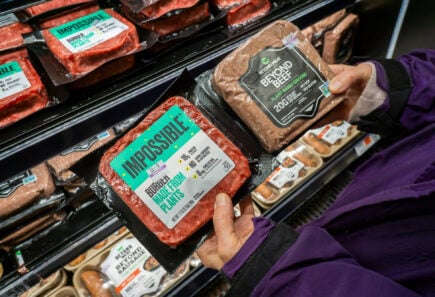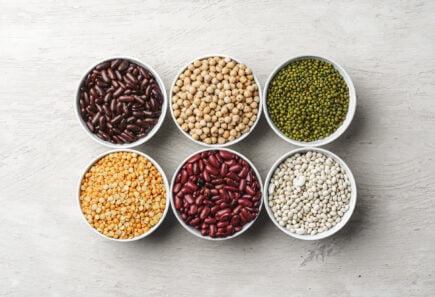
U.S. retail market insights for the plant-based industry
Explore our analysis of U.S. retail sales data for plant-based meat, dairy, eggs, and more, including category insights, size, growth, and purchase dynamics for the market.
The plant-based food industry is evolving
Watch our quick introduction to the plant-based food market in U.S. retail, including highlights on current challenges and opportunities in the plant-based meat and seafood category.
Innovation and investment have driven a decade of strong growth
Over the past decade, the plant-based food market in U.S. retail has grown substantially. When we began tracking plant-based food sales in U.S. retail, we sized the 2017 market at $3.9 billion, according to SPINS data. In 2023, the market was worth $8.1 billion. This growth has been driven by products that appeal to mainstream consumers by mimicking the taste, texture, and functionality of conventional animal products. Companies from startups to large food manufacturers generated that growth through significant innovation and investment in their plant-based portfolios. Consumers have more options than ever when selecting plant-based meat and seafood, egg, and dairy products that can be swapped in for their conventional counterparts, and many plant-based categories increasingly make up notable shares of overall meat, dairy, and egg categories.
Challenging market signals
Against this backdrop of long-term progress, 2023 was characterized by a more challenging market environment. Following the rapid expansion of the U.S. plant-based retail market from 2019 to 2021, sales moderated in 2022 and declined in 2023. Plant-based price increases coincided with elevated inflation and tight consumer budgets, and purchase dynamics indicated weakening consumer engagement in plant-based categories. There are additional signals that, for the market to see sustained growth, products will need to better deliver on the key consumer drivers of taste, price, and convenience, while offering clear propositions to entice consumers to make the switch.
These are solvable challenges
These are solvable challenges. This year’s setbacks are against a backdrop of high potential and strong consumer tailwinds. Currently, taste and price performance is limiting the category’s engagement with meat-eaters. Yet U.S. consumers say they’d be more willing to eat plant-based meat if it tasted better and were more affordable. This underscores the opportunity for brands to innovate to improve the eating experience of their products. Companies and retailers can work to lower prices. The industry can collaborate to communicate to consumers the unique value their products provide. To create sustained, long-term growth, stakeholders must take action to better meet consumer needs and return plant-based foods to sustainable growth.
Note: We’ve summarized highlights from the data below to help you understand key metrics for the U.S. retail plant-based food industry. We cover both the plant-based food market as a whole and key plant-based categories like meat and milk
In U.S. retail alone, plant-based foods are an $8.1 billion market
Insights released by the Good Food Institute (GFI) and the Plant Based Foods Association (PBFA) based on retail sales data commissioned from SPINS show that the 2023 U.S. retail plant-based food market was worth $8.1 billion. Plant-based unit sales were down 9 percent from 2022, while dollars were down 2 percent.

The U.S. retail market for plant-based foods is worth $8.1 billion.
6 in 10 U.S. households purchased plant-based foods in 2023, similar to the prior year.
Plant-based foods made up 1.1 percent of total retail food and beverage dollar sales in 2023.
95% of households that bought plant-based meat and seafood in 2023 also bought animal-based meat.
These declines were larger than those experienced by total food and beverage and animal-based food sales in 2023. Overall sales for total food and beverage at U.S. retail fell 2 percent while dollars grew 6 percent. Conventional meat and seafood unit sales declined 2 percent and dollar sales were flat. This context demonstrates that 2023 was a year in which consumers slowed their food purchases across the grocery store—not just in plant-based foods. Yet plant-based foods experienced outsized declines.
Plant-based food unit sales fell across most categories tracked in this dataset in 2023, while dollar sales increased for some. Plant-based milk dollar sales increased 1 percent while units declined 8 percent. Plant-based meat and seafood dollar sales declined 12 percent and units declined 19 percent. Plant-based creamers, protein powders and liquids, and baked goods and other desserts were the three plant-based categories that saw growth in both dollar and unit sales in 2023.
Inflation and price increases are impacting the market
One important factor influencing consumer shopping behavior in 2023 was the continued impact of price increases and inflation. In 2023, food-at-home prices were 5 percent higher than the year prior, twice the 20-year average for retail food price inflation. That growth was on top of an 11 percent increase in food-at-home prices in 2022, meaning consumers spent significantly more on groceries in 2023 than they did just a few years ago. This trend was apparent in the plant-based and conventional retail data. Average plant-based food prices increased 8 percent in 2023 and 18 percent versus 2021. Conventional meat and seafood prices increased +3 percent in 2023 and +16 percent from 2021 to 2023. In an inflation-driven market, many consumers chose to trade down within protein categories, posing salient challenges for plant-based categories whose products often sit at a premium to their conventional counterparts.

Opportunities to adapt to evolving consumer needs
2023 represents a challenging moment for plant-based foods in U.S. retail. Many consumers have unmet expectations and needs. For plant-based meat specifically, a 2023 report from Mintel indicates that over a quarter of all U.S. consumers are lapsed plant-based meat purchasers, meaning they purchased plant-based meat products in the past but did not do so in the following three months. One bright spot is that consumers are open to returning to the category. Based on a December 2023 survey conducted by Morning Consult on behalf of GFI, when asked what would convince them to buy a new plant-based meat product, the top reasons were taste and price. 49 percent identified taste and texture being exactly like conventional meat when they try a sample, and 43 percent identified plant-based meat costing less than conventional meat, followed by other attributes like a label showing less fat, less cholesterol, or more protein than conventional meat, or environmental impact. It’s clear that challenges in attracting and retaining consumers are primarily driven by these two key factors of taste and price. We discuss each in more detail below.
Taste: A primary consumer motivator
According to a survey Morning Consult conducted on behalf of GFI in August 2023, consumers identified taste-related factors as the primary motivators behind either avoiding plant-based meat altogether or not returning to the category after trying plant-based meat products.


Nailing the taste experience is critical in order to win over consumers for protein purchases and for retail food decisions in general. For plant-based categories, particularly meat, to effectively compete with conventional products, products will need to meet or exceed consumer expectations around taste. This will be necessary—but likely not sufficient—to attract consumers for the long term, as additional barriers like price must also be overcome, and mainstream consumers will need a compelling switching proposition.
Price: Narrowing the gap is crucial
Another barrier shoppers face when it comes to purchasing plant-based foods is price. Price increases have majorly impacted consumer decisions in the past few years. At the start of 2023, Morning Consult reported that 67 percent of U.S. consumers were very concerned about grocery inflation. Although the share of shoppers looking for deals or discounts declined from December 2022 to December 2023 as inflation eased, 71 percent were still doing so at the end of the year. In short, grocery prices—despite improved inflation rates from 2022—were consumers’ top economic concern and likely played a role in shifting their purchasing decisions.
Plant-based categories often sit at two-to-four-times the price of conventional products and, therefore, tend to rely on other product benefits—such as health, sustainability, and animal welfare—to attract consumers. Unfortunately, research shows that altruistic benefits are not top purchasing motivators for U.S. consumers. Narrowing the price gap while delivering other tangible benefits to consumers will allow these products to better compete with their conventional counterparts.

Outlook: Signals and opportunities
Despite these challenges, there are important tailwinds in the plant-based foods sector.
- There are significant demographic opportunities. By 2040, consumers aged 16–40—66 percent of whom plan to spend more on plant-based meat and milk in the future—will represent 69 percent of global spending.
- There is substantial consumer aspiration to reduce meat intake and increase plant-based food consumption. Roughly 33 percent of U.S. adults who eat meat and poultry report actively trying to reduce their meat and poultry intake. Additionally, 66 percent of global consumers aged 16–44 report that they plan to spend more on plant-based meat and dairy alternatives in the future.
- There’s an enormous potential market for plant-based foods—in U.S. retail, annual conventional meat sales are over $100 billion and conventional milk sales are $17 billion. Plant-based foods that can meet consumer needs by achieving taste and affordability to compete with their conventional counterparts have large market potential. Today, 95 percent of households buying plant-based meat and seafood already purchase conventional meat. The most engaged plant-based meat and seafood-purchasing households are spending up to a third of their total meat purchases on plant-based meat and seafood (based on a migration segmentation study GFI commissioned from NielsenIQ).
- Taste and texture progress is one of the main drivers of plant-based foods’ emergence over the past decade—yet there’s more work to be done. Providing a substitutable product for conventional milk and merchandising it in the refrigerated milk set to appeal to omnivore consumers drove plant-based milk’s rise to represent ~15 percent of fluid milk dollar sales. In the last few years, plant-based meat products that taste and look like conventional meat products have come to represent the majority of the plant-based meat category, with their growth outpacing that of bean burgers and traditional veggie burgers. Yet consumers still identify taste as the number one barrier to purchasing plant-based meat.
- The price gap remains a substantial barrier as well. Today, plant-based products sell at per-pound or per-gallon prices two times (milk and meat) to four times (eggs) more expensive than their conventional counterparts. Yet the market has seen individual product lines that have come to market in the past five years close the pricing gap as companies scale up.
There is substantial consumer interest in buying plant-based alternatives to these staple products found in nearly every U.S. home. For these alternatives to become everyday options, milestones on taste, price, and value must be met.
Summarizing plant-based food market sales data

Overview
In 2023, total plant-based food dollar sales declined 2 percent while unit sales declined 9 percent. Six in 10 U.S. households purchased plant-based foods, similar to the prior year.

Sales declines for total plant-based foods in 2023 were greater than the unit declines experienced in total food and beverage and conventional categories. Average prices per unit increased across total food and beverage for the second straight year, resulting in increased dollar sales while unit consumption fell. The last two years marked a shift in the retail landscape as consumers continued to feel the impact of grocery inflation.
62 percent of households purchased plant-based foods in 2023. Of that group, eight in 10 households purchased plant-based foods multiple times. Out of total households in the U.S., this means that 50 percent purchased plant-based foods multiple times, 12 percent did so only once, and 38 percent did not purchase at all in 2023.

Categories
Plant-based food categories exist in various stages of development, and unit sales declined across most categories in 2023. Plant-based milk remains the largest category with nearly 15 percent market share of total milk dollar sales. Emerging categories such as plant-based eggs also experienced declines in 2023 after unit sales grew 25 percent in 2022.

Key insights
- Plant-based milk is the most developed of all plant-based categories. Plant-based milk dollar sales slightly increased to $2.9 billion in 2023 despite unit declines, driven by price increases.
- Plant-based meat and seafood dollar and unit sales fell for the second straight year. This further reinforces the need to not only reach more consumers but also deliver on consumers’ expectations to drive repeat purchases.
- As was the case across total food and beverage and the majority of conventional categories, unit sales declined for most plant-based categories while dollar sales were significantly impacted by price increases. A few categories, including plant-based creamers, protein liquids and powders, and baked goods and other desserts, managed to grow both unit and dollar sales.
- Plant-based creamer remains a bright spot. As the third largest plant-based category, creamer continued to experience meaningful growth, even amidst a challenging market. Unit sales increased 14 percent from 2021 to 2023 while dollars climbed 35 percent in the same timeframe.

Overall consumer demographics
Plant-based food category purchases are more likely among select consumer demographics. Relative to the average household, purchasers of plant-based foods tend to be younger, come from higher-income households, and have graduate degrees. Asian American consumers are also more likely to be buyers of plant-based foods.
Improving product affordability can play a significant role in reaching a wider group of consumers given that lower-income households are less likely than average consumers to purchase plant-based products.

Note: Buyer index indicates if a certain group is more or less likely to purchase in the category compared to the average household. Dollar index indicates the extent to which a certain groups spends more or fewer dollars in the category compared to the average household. A value of 120 or more indicates over-indexing and a value of 80 or less indicates under-indexing.
Closing the price gap
In 2023, every plant-based and conventional food category GFI has data on—as well as the total food and beverage retail category—saw average prices per unit grow. Consumers continue to see higher prices at the shelf, making the price gap between plant-based and their conventional counterparts a relevant challenge to brands hoping to reach a broader swath of consumers.
Plant-based manufacturers can drive appeal and establish their products as everyday options by closing this price gap. In 2023, pound for pound, the average price premium was 77 percent for plant-based meat and seafood. Per dozen, the average price premium for plant-based eggs was 317 percent, and gallon for gallon, the premium for plant-based milk was 104 percent.

The plant-based egg category made notable progress toward price parity in 2022, with the outbreak of highly pathogenic avian influenza (HPAI) causing conventional egg prices to rise. However, in 2023, as the HPAI outbreak subsided and conventional egg prices restabilized, the gap widened closer to 2021 levels. In 2022, plant-based eggs cost roughly $5 more than animal-based eggs. In 2023, the difference between plant-based and animal-based eggs returned to more than $8 more per dozen.
While plant-based categories experienced lower price growth in 2022 compared to total food and beverage and some conventional categories, the opposite was true in 2023. For example, conventional meat and seafood prices per unit grew 13 percent in 2022 and just 3 percent in 2023 while plant-based meat and seafood prices increased 7 percent and 9 percent over the same period. In total, from 2021 to 2023, plant-based meat and seafood’s average price per unit increased 17 percent compared to conventional meat and seafood’s increase of 16 percent. Bringing down prices of plant-based foods will be critical for these products to effectively compete with conventional foods.
Purchase dynamics
Recent sales declines in the plant-based foods market can be primarily attributed to declining velocities and modest distribution losses across retailers. Additionally, household penetration for the total sector declined slightly over the last two years, indicating that there are fewer shoppers engaged in the space.

Key insights
- Six in ten households purchased plant-based foods in 2023. The majority of U.S. households purchased plant-based products, similar to in 2022.
- Plant-based milk had the largest share of households purchasing among plant-based categories. Nearly half of U.S. households purchased plant-based milk at least one time in 2023. Additionally, nearly 80 percent of those households were repeat purchasers.
- Plant-based meat and seafood were purchased by 15 percent of households. Among those households, 62 percent purchased multiple times in the category.
- Plant-based creamers reached as many households as plant-based meat and seafood did. 15 percent of households in the U.S. purchased plant-based creamers in 2023, up from 11 percent in 2020.
- Many plant-based categories saw household penetration rates fall somewhat in 2023. All plant-based categories tracked in the dataset saw household penetration rates decline or stay flat versus 2022 levels. Notably, plant-based meat and seafood fell from 19 percent in 2022 to 15 percent in 2023, indicating a need to reengage consumers.
- Most repeat purchase rates held steady in 2023. Across the majority of plant-based categories, repeat rates held relatively steady year over year.
- Households that purchased in one plant-based category were much more likely to be purchasers of other plant-based categories. For example, 25 percent of households purchasing plant-based milk also purchased plant-based meat and seafood, compared to 15 percent of total households. And 67 percent of households purchasing plant-based meat and seafood also purchased plant-based milk, compared to 44 percent of total households.
- Households that purchased both plant-based and conventional meat are high-value consumers. Households buying both plant-based and conventional meat spent 20 percent more by dollars (and 17 percent more by units) on total food purchases than the average household and 21 percent more by dollars (and 18 percent more by units) than households only buying conventional meat in 2023. Price points and household sizes likely play a role in this increased spending. Nonetheless, consumers purchasing plant-based meat and seafood are valuable shoppers.

Plant-based meat and seafood
After record growth in recent years, plant-based meat and seafood saw sizable declines in the last two years. Plant-based meat and seafood dollar sales were down 12 percent and unit sales were down 19 percent in 2023.

Plant-based meat and seafood sales
2023 marked a year of sales declines for plant-based meat and seafood, with losses in the double digits.

These trends reflect a return to pre-pandemic sales levels following unprecedented food-at-home growth during the early stages of the Covid-19 pandemic in 2020—dollar sales in 2023 were roughly $240 million above 2019 levels. They also signal opportunities to better meet consumer needs and expectations on the key drivers of consumer choice—taste, price, and convenience. For more information and analysis on the plant-based meat and seafood category’s sales performance, read our plant-based meat sales analysis, where we share insights into where the plant-based meat and seafood category is today and what that means for its future.
Key insights
- Plant-based meat and seafood sales fell significantly in 2023. In the past two years, unit sales decreased 26 percent from 289 million units in 2021 to 215 million units in 2023. Notably, packaged conventional meat and seafood unit sales also declined over the same period from 12.9 billion units in 2021 to 12.2 billion units in 2023, or -6 percent. So, from 2021 to 2023, plant-based meat and seafood sales declined by 74 million units, while packaged conventional meat and seafood sales declined by 713 million units. This dynamic underscores that, while plant-based meat and seafood is experiencing substantial declines, it’s within a context of broader meat and seafood unit declines. Many of the same consumer pressures, like price, are likely impacting both the conventional meat and seafood and plant-based foods markets.
- Plant-based meat and seafood’s market share was ~1 percent of the total meat category in 2023. In 2023, plant-based meat and seafood’s share was 1.8 percent of total retail packaged meat dollar sales or 0.9 percent of the total meat category* (including random-weight meat), down very slightly from 2022.
- Plant-based meat and seafood’s market share in the natural channel is in the double digits. In the natural channel—where retail trends tend to start before disseminating into grocery and mass—plant-based meat and seafood’s market share of packaged meat dollar sales is just shy of 12 percent (6 percent of total meat including random weight), compared to its 1.8 percent share of total marketplace packaged meat dollar sales (0.9 percent of total meat including random weight).
- Attracting and retaining more households are major opportunities for plant-based meat and seafood. In 2023, 15 percent of households purchased in the category, down from a high of 20 percent in 2021. In simplified terms, this decline alone could explain the amount of unit sales declines seen over the same timeframe. It’s notable that repeat purchase rates have stayed relatively flat. This signals that loyal shoppers maintained purchases while sales declines were driven by households leaving the category in 2023. Reengaging these households is a clear opportunity.
- Plant-based meat and seafood shoppers are similar demographically to overall plant-based food shoppers. In particular, plant-based meat and seafood buyers are more likely to be Asian. African American or Gen X buyers are more likely to spend more in the plant-based meat and seafood category.
*SPINS does not report non-UPC animal-based meat counter sales, only UPC packaged meat sales. To calculate the plant-based meat and seafood share of the total meat category, GFI develops dollar and unit volume assumptions for non-UPC animal-based meat counter sales and adds them to the SPINS UPC animal-based meat sales.
Segment insights: Refrigerated vs. frozen vs. shelf-stable

- In 2023, the share of plant-based meat and seafood dollar sales in the frozen department grew to nearly 70 percent (up from 61 percent in 2021), followed by refrigerated at 30 percent (down from 38 percent in 2021) and shelf-stable at 2 percent (slightly up from 1 percent in 2021).
- Unit sales declines in refrigerated outpaced declines in frozen over the last two years. Refrigerated unit sales declined 33 percent from 2021 to 2023, while shelf-stable grew 30 percent, albeit off of a small base. Consumers are shifting their spending to the frozen department for plant-based meat and seafood purchases.
- Notable factors likely contributing to this dynamic include:
- Retailers shifting products to the frozen department to extend shelf life and consolidate store sets.
- Notable product launches and line extensions in the frozen aisle including steaks, nuggets, and cutlets, while new activity in the refrigerated aisle is relatively limited. Similarly, there was little activity in shelf-stable product launches in 2023.
- Average price-per-unit increases soared +26 percent for frozen products from 2021 to 2023 while refrigerated grew just 4 percent in the same timeframe. Shelf stable prices jumped +11 percent. These price increases, although bolstering frozen dollar sales, may play a role in declining unit sales across the frozen aisle.
- Historically, refrigerated plant-based meat and seafood was a key growth driver for the category, as it is frequently shelved in the meat case (rather than a specialty vegan case). This enabled it to be located in the section of the store where most shoppers look for center-of-plate proteins.
For more insights on how to capitalize on merchandising strategies for the plant-based meat and seafood market, check out our merchandising guide.
Segment insights: Plant-based meat and seafood formats

- Plant-based patties continued to be the largest plant-based meat and seafood product type, followed by (2) nuggets, tenders, and wings, (3) grounds, (4) hot dogs, brats, and sausages, and (5) breakfast links and patties.
- Together, these five segments made up nearly 80 percent of all plant-based meat and seafood dollar sales in 2023.
- Meanwhile, recent product launches extended into other formats such as filets, steaks, and cutlets.
Segment insights: Animal types

- Plant-based beef remained the largest animal-type subcategory by dollar sales, followed by plant-based chicken and pork.
- 2022 saw growth in plant-based chicken and seafood, but 2023 was a down year for all animal types in the plant-based meat and seafood category.
- While both analog products (like plant-based beef, chicken, and pork) and plant-forward products (like black bean burgers) experienced double-digit sales declines, plant-forward products declined more than analogs did. In the last 2 years, the plant-forward segment decreased 29 percent by dollars and 41 percent by units, while the analog segment decreased 11 percent by dollars and 24 percent by units. This indicates that analog products that mimic the taste and texture of conventional meat remain the primary retail play.
Purchase dynamics
Household penetration and repeat purchase
- 15 percent of U.S. households purchased plant-based meat and seafood in 2023. This is significantly down from the peak of 20 percent in 2021. Notably, this is roughly double the penetration rate of tofu, tempeh, and seitan, signaling that this next generation of meat alternatives that looks, cooks, and tastes similar to conventional meat has helped unlock consumer interest.
- The majority of shoppers are repeat purchasers. 62 percent of households purchasing plant-based meat and seafood made repeat purchases within the category. Among plant-based categories, this was third to plant-based milk (79 percent) and plant-based creamer (65 percent).
- Households that purchase plant-based and conventional meat spend more per household. Households buying both spent 20 percent more on total food purchases than the average household and 21 percent more than households only buying conventional meat in 2023.
Co-purchasing
- Households purchasing plant-based meat and seafood are much more likely to be purchasers of other plant-based categories. Of households that purchased plant-based meat and seafood in 2023, 67 percent also purchased plant-based milk compared to just 44 percent of total households. The same is true for other plant-based categories including cheese (24 percent vs 7 percent), yogurt (20 percent vs 8 percent), ice cream and frozen novelties (23 percent vs 10 percent), eggs (5 percent vs 1 percent), creamer (25 percent vs 15 percent), butter (18 percent vs 6 percent), and tofu, tempeh, and seitan (26 percent vs 8 percent).
- Shoppers in the plant-based meat category aren’t fully plant-based, however, as they often purchase animal-based products in the same basket. Conventional meat showed up in 30 percent of baskets where plant-based meat and seafood were purchased, conventional cheese in 28 percent, and conventional yogurt in 17 percent. Additionally, 35 percent of plant-based meat and seafood trips included another plant-based product (e.g., plant-based dairy or eggs).


Plant-based milk market
The plant-based milk category reached new dollar sales heights of $2.9 billion in 2023 despite unit declines. This category alone accounted for 36 percent of all plant-based food dollar sales and played a key role in overall trends.

Plant-based milk sales
Plant-based milk accounted for almost 15 percent of all dollar sales of total milk in U.S. retail in 2023. Dollar sales increased slightly by 1 percent and unit sales declined 8 percent. Conventional milk dollar sales decreased by 2 percent, as did unit sales.

Key insights
- Nearly half of all U.S. households purchased plant-based milk in 2023. Household penetration rates declined slightly, with projected buyers falling from 59 million households in 2022 to 56 million households in 2023. Like with plant-based meat, repeat rates held steady, with 79 percent of households purchasing in the plant-based milk category more than once.
- Plant-based milk is a significant part of the overall milk category. Plant-based milk made up almost 15 percent of total milk category dollar sales in 2023 and about 13 percent of unit sales.
- In the natural channel, plant-based milk composed a sizable portion of the total milk category. Innovation often starts in the natural channel, where plant-based milk represented 41 percent of all milk sold by dollar sales.
- Households with children were more likely to spend more on the plant-based milk category. This demographic trend was consistent in 2022 and 2023.
Segment insights: Plant-based milk ingredient base

- Almond milk remained the largest segment of the category at 56 percent of 2023 sales. Its dollar share of the category fell from 61 percent in 2021 as other formats gained ground.
- Oat milk captured much of that share, jumping from 18 percent in 2021 to 24 percent in 2023. Unit sales growth for oat milk did not continue in 2023 as year-to-year sales were flat, although this flattening followed 24 percent unit growth in 2022.
- Coconut milk was the only plant-based milk segment to grow unit sales in 2023, increasing 13 percent from the prior year. Still, it trailed almond, oat, and soy in total dollar sales and represented 4 percent of category sales.
- Plant-based milk continued to benefit from product innovation and merchandising of the category adjacent to the conventional milk set. The latter ensures that omnivore consumers can understand their choices and make a decision in the refrigerated section, where they are already shopping for milk products.
Segment insights: Refrigerated vs. shelf-stable plant-based milk

- Refrigerated plant-based milk continued to dominate the category, representing 89 percent of plant-based milk dollar sales.
- Today, refrigerated plant-based milk is consistently shelved adjacent to animal-based milk. This has been critical to the rise of plant-based milk to the 15 percent market share of total milk dollar sales it has today.
Plant-based milk sales
Household penetration and repeat purchase
- Among U.S. households, 44 percent purchased plant-based milk in 2023. This was down slightly—by 3 percentage points—from 2022. Plant-based milk was a major entry point for households trying products across plant-based categories.
- Plant-based milk had the highest repeat rates of any plant-based category. 79 percent of households purchased in the plant-based milk category on more than one occasion in 2023.
Co-purchasing
- Households purchasing plant-based milk were much more likely to be purchasers of other plant-based categories. Of households that purchased plant-based milk in 2023, 25 percent also purchased plant-based meat and seafood, compared to just 15 percent of total households. The same was true for other plant-based categories, including cheese (15 percent vs 7 percent), yogurt (15 percent vs 8 percent), ice cream and frozen novelties (17 percent vs 10 percent), eggs (2 percent vs 1 percent), creamer (22 percent vs 15 percent), butter (11 percent vs 6 percent), and tofu, tempeh, and seitan (14 percent vs 8 percent).
- Plant-based milk shoppers often purchased conventional meat and dairy products in the same trip, including conventional milk. Conventional meat showed up in 39 percent of baskets where plant-based milk was purchased, conventional cheese 31 percent, conventional yogurt 23 percent, and conventional milk 19 percent.


The market for other plant-based dairy and eggs
Other plant-based dairy and egg categories are in various stages of maturation.
Creamer
The plant-based creamer category had both unit and dollar sales growth in back-to-back years amidst a challenging market.

Key insights
- Dollar sales for plant-based creamers grew significantly in just two years. Consumer familiarity with plant-based milk, the largest plant-based category, and growing affinity for plant-based creamers in their beverages allowed this category to excel even in a difficult environment.
- Plant-based creamer’s market share of total creamer was 8 percent. This was the second-highest share rate among plant-based categories, behind plant-based milk.
- Plant-based creamer made up nearly a third of creamer sales in the natural channel. Dollar sales of plant-based creamer products reached 32 percent of all creamer sales in the natural channel.
- Plant-based creamer dollar sales growth outpaced that of animal-based creamer. While plant-based creamer unit sales grew 4 percent in 2023, and 14 percent since 2021, conventional creamer unit sales declined 1 percent in 2023, and 2 percent since 2021.
- 15 percent of households purchased plant-based creamers in 2023. This was up from 11 percent in 2020. Additionally, 65 percent of these households were repeat purchasers, the second highest rate of repeat purchase for plant-based categories, behind only plant-based milk.
- Households purchasing plant-based creamer tend to purchase other plant-based categories as well. For example, 71 percent of households purchasing plant-based creamer also purchased plant-based milk in 2023, compared to just 44 percent of total households purchasing plant-based milk.
Ice cream and frozen novelty
The plant-based ice cream and frozen novelty category experienced declining dollar and unit sales in 2023.

Key insights
- Unit sales declines outpaced dollar sales losses, indicating price-per-unit increases. Price increases were also the trend for animal-based ice cream in 2023, which saw unit sales decline 3 percent and dollar sales increase 5 percent. This underscores a trend seen across several animal-based categories, which is that dollar sales were pushed up into the positives by inflation despite declining unit sales.
- Companies tested new bases. Similar to the plant-based milk category, plant-based ice cream and frozen novelty saw diversification of ingredient bases—like oat—in recent years.
- Plant-based ice cream and frozen novelties were purchased by one in 10 U.S. households in 2023. This category holds the fourth highest rate of household penetration (10 percent) among tracked plant-based categories, behind milk, meat and seafood, and creamer.
- Younger consumers were more likely to be plant-based ice cream buyers. Millennials were more likely to buy and spend more on plant-based ice cream than other generations. Gen Z consumers were also more likely to buy in the category.
Yogurt
Plant-based yogurt dollar and unit sales declined in 2023, but retained a significant dollar share—almost 20 percent—in the natural channel.

Key insights
- 8 percent of households purchased plant-based yogurt. Meanwhile, 81 percent of households purchase conventional yogurt, indicating a large market opportunity if plant-based yogurt can better meet the needs of consumers looking for an alternative.
- Category repeat rates increased. A promising signal for products better meeting consumer needs: repeat rates within the category grew from 51 percent in 2020 to 55 percent in 2023.
- Plant-based yogurt’s market share of total yogurt declined slightly but remained substantial. In 2023, plant-based yogurt accounted for just shy of 4 percent of total yogurt sales in the overall retail space and just shy of 20 percent in the natural channel.
- Conventional yogurt unit sales also declined in 2023. Conventional yogurt saw unit sales fall 1 percent while dollars were elevated 11 percent, driven by price-per-unit increases.
- Younger consumers and households with children were more likely to buy and spend more on plant-based yogurt. Lower-income households were less likely to purchase plant-based yogurt, which may present an opportunity to increase consumer engagement by making products more accessible and affordable.
- A significant amount of households purchasing plant-based yogurt also purchased other key plant-based categories. 37 percent of these households also bought plant-based meat and seafood in 2023, versus just 15 percent of total households. 77 percent also bought plant-based milk, compared to 44 percent of total households.
- Conventional cheese and yogurt were often purchased in the same trips as plant-based yogurt. Conventional cheese and yogurt were purchased on 25 percent of trips where plant-based yogurt was also purchased. Other plant-based categories, like plant-based milk, were often purchased in tandem with plant-based yogurt. Plant-based milk was purchased on 24 percent of trips where plant-based yogurt was purchased.
Butter
Plant-based butter saw continued unit sales declines in 2023.

Key insights
- Unit sales of plant-based butter lagged dollar sales. From 2021 to 2023 plant-based butter dollar sales grew 5 percent while units fell 23 percent, a sign of dramatic price increases.
- Plant-based butter’s market share of total butter decreased from 2021 levels. In 2023, plant-based butter composed 4.5 percent of dollar sales for the total butter market, a full percentage point less than 2021’s market share.
- All butter and margarine prices increased dramatically. Compared to 2021, the average price per unit of plant-based butter grew 37 percent. That growth rate was slightly higher than that of animal-based butter, which grew 34 percent.
- As defined in this data set, the plant-based butter category is dominated by vegetable oil-based margarines and spreads. However, the last few years saw the launch and growth of several products more directly positioning themselves as plant-based butter products. This likely contributed to price increases within the category.
Cheese
Both dollar and unit sales declined for the plant-based cheese category in 2023.

Key insights
- Household penetration of plant-based cheese is small but saw modest growth over recent years. The percentage of households purchasing plant-based cheese rose to 7 percent in 2023 (similar to in 2022) compared to 5 percent in 2020.
- Repeat rates were down. The percentage of buyers purchasing in the plant-based cheese category more than once decreased from 56 percent in 2020 to 49 percent in 2023.
- Plant-based cheese’s dollar share of the total cheese market remained at about 1 percent over each of the last three years.
- The animal-based cheese category has high consumer engagement, offering a large potential market. Behind only animal-based meat, animal-based cheese was the animal-based category with the greatest household penetration in the U.S., at 97 percent. Converting more of those households into plant-based cheese buyers represents a large opportunity for the plant-based cheese category. However, repeat rates indicate that current products are not meeting consumers’ needs and expectations.
- Nearly half of plant-based cheese-purchasing households also purchased plant-based meat and seafood. Behind only plant-based eggs, plant-based cheese had the highest co-purchase rate of plant-based meat and seafood of any tracked plant-based category.
- Plant-based cheese shoppers often purchased other plant-based products during the same trip. Other plant-based products showed up in 55 percent of baskets where plant-based cheese was purchased. Notably, conventional cheese was also purchased on 21 percent of trips where plant-based cheese was purchased.
Ready-to-drink beverages
As several ready-to-drink beverage product types grow, consumers are seeking out plant-based products in the category. Plant-based replacements for ingredients like milk or creamer used in ready-to-drink lattes, nitro coffee brews, and teas are examples of the plant-based trend intersecting with an uptick in consumer interest in ready-to-drink beverages. The category experienced modest dollar and unit sales declines in 2023 following a year of impressive growth in 2022.

Cream cheese, sour cream, and spreads
Plant-based cream cheese, sour cream, and dips saw sales growth in 2022 turn to declines in 2023 as units fell 4 percent and dollars 2 percent.

Eggs
A segment leader in years past, plant-based eggs experienced fairly significant declines for the first time in 2023 with units falling 13 percent while dollars declined 5 percent.

Key insights
- Very few households currently purchase plant-based eggs. Just 1 percent of households purchased these products in 2023, leaving a massive growth opportunity if more consumers can be reached.
- Repeat rates increased every year since 2020. Growing from 38 percent in 2020 to 48 percent in 2023, consumers are coming back to the plant-based eggs category at an increasing rate.
- Households purchasing plant-based eggs purchase other plant-based categories at the highest rate. Despite there being just over 1 million households that purchase these items, these households are also highly engaged in other plant-based categories. For example, 75 percent of these households also purchased plant-based meat and seafood in 2023, versus 15 percent of total households. 84 percent also purchased plant-based milk, versus 44 percent of total households.
- Animal-based eggs also experienced unit sales declines in 2023. Conventional eggs saw unit sales drop 2 percent in 2023 and 4 percent from 2021 to 2023 compared to plant-based eggs’ 8 percent growth over the same two-year period.
- Conventional egg prices stabilized in 2023. The plant-based egg category made notable progress toward price parity in 2022. However, in 2023, as conventional egg prices restabilized, the gap widened again closer to 2021 levels. In 2022, plant-based eggs cost roughly $5 more than animal-based eggs. In 2023, animal-based egg prices fell dramatically, bringing the difference to more than $8 per dozen (note: for liquid eggs, we used a multiplier to equate to a dozen eggs).

Note: Plant-based eggs are not sold per dozen (or count) like conventional eggs, but rather can be tracked by weight in ounces. Because of that, the assumption of a dozen conventional eggs weighing 24 ounces was used to estimate the per dozen price for plant-based eggs.

Other plant-based foods
Additional plant-based food categories such as prepared meals, protein liquids and powders, bars, tofu, tempeh, and seitan, condiments and dressings, and baked goods and other desserts provide additional options to consumers seeking more ways to add plant-based foods to their diets.
photo credit: Mind Blow
Plant-based meals
The plant-based meals category saw a familiar trend of both dollar and unit sales declines in 2023. Incorporating plant-based meat and seafood, egg, and dairy ingredients into ready-to-eat meals is an important prong of providing customers with convenient meal solutions that meet their needs.

Plant-based protein liquids and powders
A bright spot in the plant-based segment, protein liquids and powders mustered both unit and dollar sales growth in 2023, continuing their growth from 2022. Plant protein is seizing the moment as consumers turn towards better-for-you products and look to add protein to their diets. In the natural channel, this category made up an impressive 45 percent of all protein liquids and powders sales, the highest natural channel share value of any plant-based category.

Plant-based protein bars
Plant-based bars continued to experience unit declines while dollars grew due to price increases.

Tofu, tempeh, and seitan
The tofu, tempeh, and seitan category performed relatively well in 2023 compared to other plant-based and conventional categories. Despite a modest fall in unit sales, dollars remained elevated and price increases remained manageable. Tofu, tempeh, and seitan may be increasingly appealing to consumers as a meat alternative, particularly during times of inflation.

Condiments and dressings
Similar to other categories, dollar sales of plant-based condiments and dressings lost unit sales while dollars remained just above zero in 2023.

Baked goods and other desserts
A relatively new category in this reporting, plant-based baked goods and other desserts were a highlight of 2023 with positive unit and dollar sales growth.

The plant-based baked goods and other desserts category was constructed by compiling vegan-coded items held within the SPINS shelf-stable Baked Goods subcategory as well as plant-based frozen and refrigerated pies, baked goods, pastries, doughs, and other desserts.
About the data
Point-of-sale data
To size the U.S. retail market for plant-based foods, GFI and PBFA commissioned retail sales data from the market research firm SPINS. The firm built the dataset by first pulling in all products with the SPINS “plant-based positioned” product attribute. The dataset was further edited by adding plant-based private-label products. Inherently plant-based foods, such as chickpeas and kale, are not included.
Due to the custom nature of these categories, the retail data presented on this page may not align with standard SPINS categories. Additionally, SPINS pulled in relevant mainstream subcategories (excluding plant-based positioned products) in order to create the conventional categories discussed above. Finally, the total food and beverage category was pulled by bringing in all grocery, frozen, and refrigerated edible items across the retail grocery landscape, as well as protein powders and bars. SPINS obtained the data over the 52-week, 104-week, 156-week, and 208-week periods ending December 3, 2023, from the SPINS Natural Supermarket Channel, SPINS Conventional Multi-Outlet Channel, and SPINS Convenience Channel (powered by Circana).
SPINS defines these channels as follows:
- Conventional Multi Outlet (MULO): More than 110,000 retail locations spanning the grocery outlet, the drug outlet, and selected retailers across mass merchandisers, including Walmart, club, dollar, and military.
- Natural Supermarket Channel: More than 1,900 full-format stores with $2 million+ in annual sales and 40 percent or more of UPC-coded sales from natural/organic/specialty products.
Convenience Channel: More than 147,000 convenience locations that are less than 5,000 square feet, have extended hours, stock at least 500 SKUs, and provide a mix of grocery items like beverages, snacks and confections, and tobacco.
This is generally considered the broadest available view of retail food sales, although not all retailers are represented. Some companies, such as Whole Foods Market, Trader Joe’s, and Costco, do not report their scan data to Circana but are represented via projections. Please note that this methodology has changed compared to that used in previous reporting by GFI. We do not recommend comparing data released in prior years to the data included here.
Consumer panel data
To understand consumer purchasing dynamics and demographics, GFI and PBFA also commissioned consumer panel data from SPINS. The process for pulling the panel data was separate from that for the POS data, which may result in minor category differences. SPINS combines Circana Scan Panel with proprietary Product Intelligence to provide a unique view into shopper incrementality, loyalty, cross-purchase, demographics, and more. SPINS obtained the data over the 52-week, 104-week, 156-week, and 208-week periods ending December 3, 2023, from all U.S. outlets.

About SPINS
SPINS connects shopper values to product innovation by combining POS data across conventional, eCommerce, and natural channels with deep product knowledge. By translating product data into attributes, we ensure retailers, brands, and their partners know just as much about the products they create, stock, and sell as the shoppers that buy them. These attributes create a common language that promotes collaboration and growth across the ecosystem.
Lead authors


Emma Ignaszewski
ASSOCIATE DIRECTOR, INDUSTRY INTELLIGENCE & INITIATIVES
Emma Ignaszewski oversees the corporate engagement team’s industry intelligence and initiatives to catalyze corporate innovation that will radically transform the food system and deliver alternative protein products that compete on the key drivers of consumer choice: taste, price, and convenience.
Co-authors


Support our work
Our industry engagement is made possible thanks to our generous, global family of donors. Philanthropic support is vital to our mission. Connect with us today to discuss how you can help fuel this transformative work.
Check out related resources

Consumer insights
Understand consumers, demographics, adoption, motivations, category descriptors, and opportunities for future research in alternative proteins.

Alternative protein company database
Explore the landscape of plant-based, cultivated, and fermentation companies including consumer brands, manufacturers, and ingredients companies.

Plant Protein Primer
Find information on nutrition, functionality, price, sourcing, and consumer perceptions of plant protein sources for plant-based meat.
Contact us
Have questions? Would you like to learn how to work with us? Get in touch!




